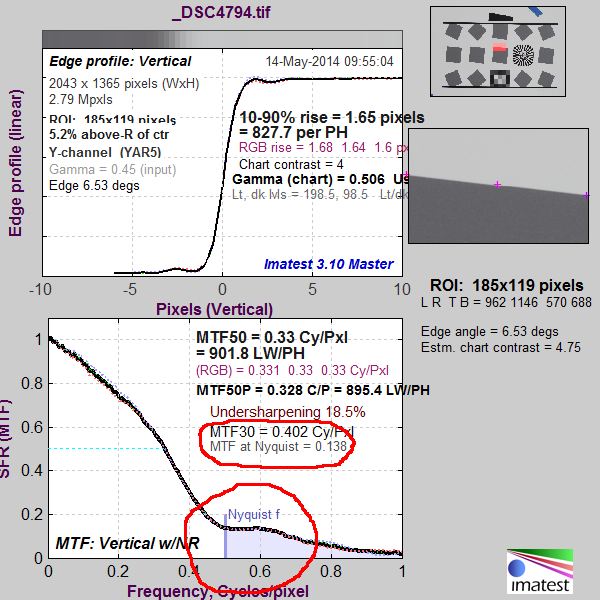There is a trend in the camera marketplace to offer cameras with no antialiasing (AA) filters. None of the medium format camera that I know of use such filters. Recent full frame and APS-C cameras from Leica, Sony and Nikon have also dispensed with AA filters.
In the recent posts about Imaging System Q I ran simulations that showed that diffraction limited lenses at commonly used f-stops could create aliasing on cameras without AA filters unless the sensor resolution was much higher than any full frame sensor currently available. In yesterday’s post, I showed that a good-quality lens on a high-resolution digital camera is diffraction-limited at f/11, and nearly so at f/8. This means that we can expect aliasing on cameras without AA filters in the real world.
Imatest offers a measurement that gives a good look at aliasing potential of any camera/lens combination; it will compute the MTF at the Nyquist frequency. Any image spatial frequency energy above that frequency will appear improperly in the final image.
Let’s look at an example. This is an Imatest analysis of an f/5.6 image from the Sony alpha 7R/Zeiss 55mm Otus f/1.4 series that was the subject of yesterday’s post. I have indicated the Nyquist frequency and the MTF at that frequency. The blue-shaded part of the MTF curve is the problem area.
MTF at Nyquist is not a perfect predictor of aliasing. A better metric would be the area under the MTF curve on the high side of the Nyquist frequency. But it should be useful. If we take the MTF at Nyquist results of the real Otus on the real Sony and compare them to the simulation of a diffraction limited lens on a prefect camera of the same resolution, we get this:
You can see that the real lens has an MTF at Nyquist the same or higher than the ideal lens at f/11, when used at all the tested f-stops. Let’s assume for a minute that the point spread function for a real lens is similar to an Airy pattern (it’s not, and I’ll be examining this issue in a future post).
If we take the sensor pitch necessary to get an Imaging System Q of 2 or 2.8 with an ideal lens at f/11, that ought to give us a lower bound on the resolution required to get the most out of the Otus. That pixel pitch is 2.2 um at a Q of 2.8, and 3,1 um at a Q of 2.
Similarly, if we take the sensor pitch necessary to get an Imaging System Q of 2 or 2.8 with an ideal lens at f/8, that ought to give us an upper bound on the resolution required to get the most out of the Otus. That pixel pitch is 1.6 um at a Q of 2.8, and 2.2 um at a Q of 2.
2.2 um pitch implies a 178 megapixel full frame sensor. 1.6 um is twice that. 3.1 um is half that.
We’re a long way from having sensors that can do justice to lenses as good as the Otus.


Hi Jim,
Excellent work as always. One thing that stands out to me is that unusual looking MTF curve (the sharp knee just before Nyquist). I wonder if the bumps in the ESF/LSF profile have anything to do with it: ESF/LSF profiles are supposed to be monotonically increasing functions.